Conference Venue
|
 Braganca is a is a beautiful city and municipality, full of history and heritage, in north-eastern Portugal and the capital of Bragança District, in Alto Trás-os-Montes. The area around Bragança is known for its impressive scenery, such as the The Douro and Montesinho region. Braganca is a is a beautiful city and municipality, full of history and heritage, in north-eastern Portugal and the capital of Bragança District, in Alto Trás-os-Montes. The area around Bragança is known for its impressive scenery, such as the The Douro and Montesinho region.
The population of the municipality is 34,774 and its total area is 1,173.6 kmª. It lies on a branch of the Sabor River south of the Culebra Mountains, 255 km northeast of Porto, 515 km from Lisbon and 22 km. from the Spanish border. The city is at an elevation of 700m. Of all of the 18 Portuguese district capitals, Bragança is the farthest from Lisbon, the national capital. The seat of the municipality is the city of Bragança, which consists of two parishes (Sé and Santa Maria) and has a population of about 21,000. The neighbouring municipalities are Vimioso in the southeast, Macedo de Cavaleiros in the southwest and Vinhais in the west.
|
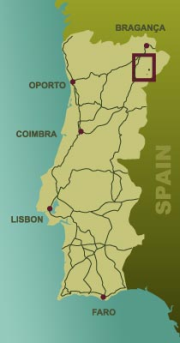
|

History
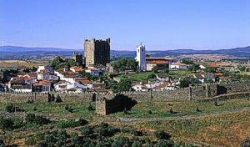
|
Originally Bragança was a Celtic city known as Brigantion, (Brigantia, the name of a celtic goddess), it later romanized its name to the present form. The Romans gave the name of "Juliobriga" to the original fortified village. Bragança grew in importance due to its location and rich agriculture so this fortification was improved upon especially in the time of King Dom Afonso I who constructed a proper walled citadel for his brother-in-law Fernão Mendes. Completed around 1130 the place was then renamed "Brigantia".
|
|
King Afonso IX of León occupied the town and soon King Sancho I retook possession and built the castle that still remains. This town also gave its name to the last in the royal Portuguese lineage, the House of Bragança, that descended from the an illegitimate son of Dom João I who was created a Duke in 1442.
The tower of the castle was to become a place of imprisonment or refuge for many historic personages including Dona Sancho, the unfortunate wife of its constructor.
|
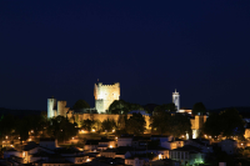
|
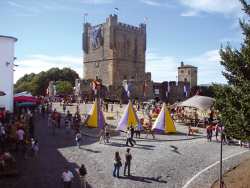
|
Historically the city has been important as the seat of the House of Bragança, which provided the kings of Portugal from 1640 to 1910 and the emperors of Brazil from 1822 to 1889; their feudal castle (built 1187) still remains. Catherine of Bragança became the queen consort (1662) of Charles II of England. The town played its strategic part in many battles between the two Kingdoms of Portugal and Spain. It was also the location in which General Sepúlveda in 1808 called upon the local inhabitants to resist against the invasion of the French forces.
|
|
The isolated walled citadel dates from the 12th century and is surprisingly well preserved: it is worth admiring the Castle, with its watchtowers and dungeons, the pentagonal Domus Municipalis (an unique example of Romanesque civic architecture in Portugal, which served as a meeting place for the «good men» of the county) and which until the 16th Century was used as a reservoir for water and then converted into a building that was used as a civic court for disputes between tradesmen and landowners.
|
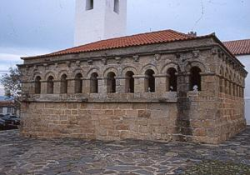
|

|
Still within the citadel you can find the church of Saint Mary dating back to 1580, which exhibits an elaborate carved portal restored in the 18th century. The first church was named Nossa Senhora do Sardão (Our Lady of the Green Lizard!), the creature said to protect the inhabitants from the Moors.
Close to the walls of the castle in the adjoining garden is a medieval pillory in the unusual shape of a pig being skewered which dates back to Celtic period.
|
|
Outside the walls in the Rua dos Fornos is the Jewish quarter that was formed by Jews fleeing from Spain and North Africa in the 15th Century. They were responsible for starting the local silk industry. In the Museu do Abade de Baçal is a variety of items including some medieval torture instruments and in the gardens outside some archaeological finds are on display including tablets with Luso-Roman inscriptions.
|

|
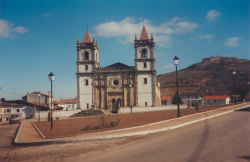
|
The Church of São Vicente, built in the 13th century and reconstructed in the 17th, is reputed to be the location in which the secret wedding of King Dom Pedro and Inês de Castro took place. Originally a 13th Century structure it was rebuilt in the 17th Century with several rich adornments. The Church of São Bento dates back to the 16th Century with some 18th Century additions.
|
More great pictures of Braganca can be found under Flickr
Parts of this text were copied from 
Conference Location
Getting to Braganca
By Plane


 |
The Francisco Sá Carneiro in Porto (OPO) airport is the nearest International airport. Other possibilities are Lisbon Airport (LIS), and Spanish airports, namely: Valladolid (VLL) (2 hours from Bragança by Bus) and Barajas in Madrid (MAD). However, we strongly recommend Porto Airport in order to organise bus travelling to Bragança.
Domestic Flights
The city has a small airport: Aérodromo de Bragança (BGC), with scheduled flights to Lisbon (LIS, which only take 90 min. There are 2 daily flights Lisbon-Bragança and Bragança-Lisbon on weekdays. For more information including schedules and fares and for online reservation visit the webpage of the operator.
|
By Bus
 |
The conference organization will provide a bus from Porto-Bragança and Bragança-Porto (Francisco Sá Carneiro Airport - Porto), between 4.00 p.m. and 4.30 pm in the afternoon of June 23rd and at 8.00 a.m.-8.30 a.m. in the morning of June 27th. (2 hours from Bragança by Bus)
Alternatively, there are daily bus connections from Porto, Lisbon and other major cities to Bragança.
The following bus companies travel to and from Bragança:
• Rede eXpressos (on line ticketing available)
• RodoNorte (online schedules and fares)
• Santos (online schedules and fares)
|
By Car
 |
The principal motorway is the estrada IP 4 connecting the cities of Bragança, Mirandela, Vila Real, Amarante, Penafiel and Oporto (Porto).
|
Braganca Maps
Click on the above maps for a bigger view
Useful Links
SPONSORED BY
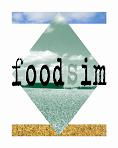




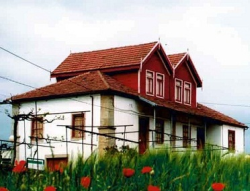

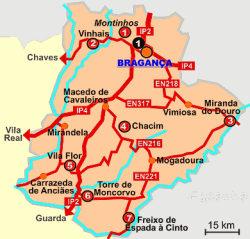
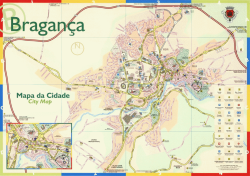
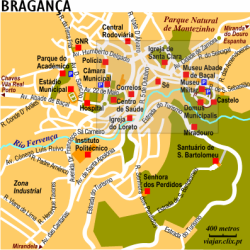











 Tel: +351 273 303 382
Tel: +351 273 303 382 Fax: +351 273 303 319
Fax: +351 273 303 319 Email:
Email: 





 CoraNE
CoraNE









